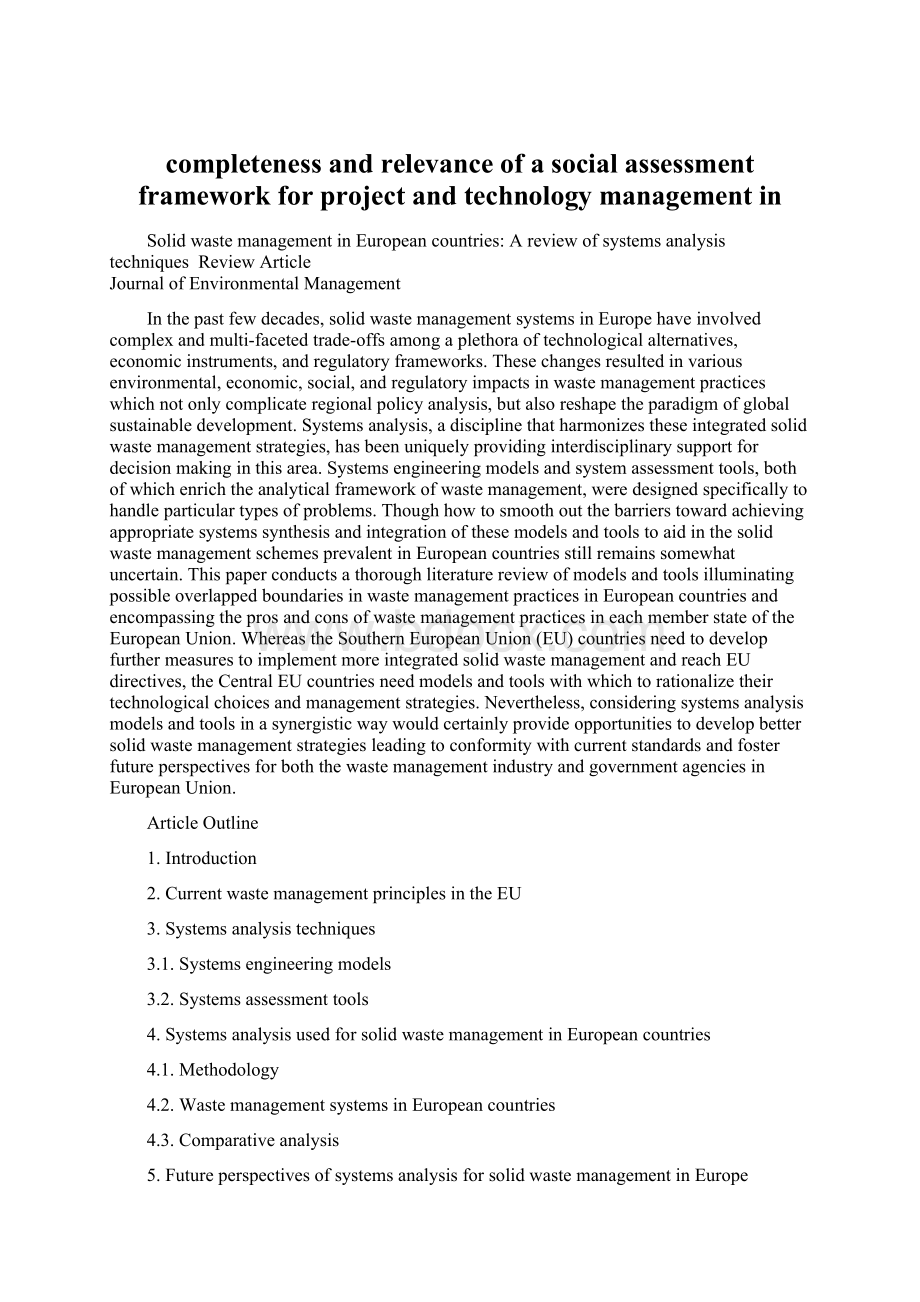completeness and relevance of a social assessment framework for project and technology management in.docx
《completeness and relevance of a social assessment framework for project and technology management in.docx》由会员分享,可在线阅读,更多相关《completeness and relevance of a social assessment framework for project and technology management in.docx(14页珍藏版)》请在冰豆网上搜索。

completenessandrelevanceofasocialassessmentframeworkforprojectandtechnologymanagementin
SolidwastemanagementinEuropeancountries:
Areviewofsystemsanalysistechniques ReviewArticle
JournalofEnvironmentalManagement
Inthepastfewdecades,solidwastemanagementsystemsinEuropehaveinvolvedcomplexandmulti-facetedtrade-offsamongaplethoraoftechnologicalalternatives,economicinstruments,andregulatoryframeworks.Thesechangesresultedinvariousenvironmental,economic,social,andregulatoryimpactsinwastemanagementpracticeswhichnotonlycomplicateregionalpolicyanalysis,butalsoreshapetheparadigmofglobalsustainabledevelopment.Systemsanalysis,adisciplinethatharmonizestheseintegratedsolidwastemanagementstrategies,hasbeenuniquelyprovidinginterdisciplinarysupportfordecisionmakinginthisarea.Systemsengineeringmodelsandsystemassessmenttools,bothofwhichenrichtheanalyticalframeworkofwastemanagement,weredesignedspecificallytohandleparticulartypesofproblems.ThoughhowtosmoothoutthebarrierstowardachievingappropriatesystemssynthesisandintegrationofthesemodelsandtoolstoaidinthesolidwastemanagementschemesprevalentinEuropeancountriesstillremainssomewhatuncertain.ThispaperconductsathoroughliteraturereviewofmodelsandtoolsilluminatingpossibleoverlappedboundariesinwastemanagementpracticesinEuropeancountriesandencompassingtheprosandconsofwastemanagementpracticesineachmemberstateoftheEuropeanUnion.WhereastheSouthernEuropeanUnion(EU)countriesneedtodevelopfurthermeasurestoimplementmoreintegratedsolidwastemanagementandreachEUdirectives,theCentralEUcountriesneedmodelsandtoolswithwhichtorationalizetheirtechnologicalchoicesandmanagementstrategies.Nevertheless,consideringsystemsanalysismodelsandtoolsinasynergisticwaywouldcertainlyprovideopportunitiestodevelopbettersolidwastemanagementstrategiesleadingtoconformitywithcurrentstandardsandfosterfutureperspectivesforboththewastemanagementindustryandgovernmentagenciesinEuropeanUnion.
ArticleOutline
1.Introduction
2.CurrentwastemanagementprinciplesintheEU
3.Systemsanalysistechniques
3.1.Systemsengineeringmodels
3.2.Systemsassessmenttools
4.SystemsanalysisusedforsolidwastemanagementinEuropeancountries
4.1.Methodology
4.2.WastemanagementsystemsinEuropeancountries
4.3.Comparativeanalysis
5.FutureperspectivesofsystemsanalysisforsolidwastemanagementinEurope
5.1.Currentstatusandlimitations
5.2.Gapsonknowledgeofwastemanagement
5.3.Researchneedsforthefuture
6.Conclusions
References
SPECIES—Co-evolutionofproducts,processesandproductionsystems OriginalResearchArticle
CIRPAnnals-ManufacturingTechnology
Manufacturingenterprisesarechangingthewaytheybehaveinthemarkettofacetheincreasingcomplexityoftheeconomic,socio-politicalandtechnologicaldynamics.Manufacturingproducts,processesandproductionsystemsresultinbeingchallengedbyevolvingexternaldrivers,includingtheintroductionofnewregulations,newmaterials,technologies,servicesandcommunications,thepressureoncostsandsustainability.Theco-evolutionparadigmsynthesisestherecentscientificandtechnicalapproachesproposedbyacademicandindustrialcommunitiesdealingwithmethodologiesandtoolstosupportthecoordinatedevolution(co-evolution)ofproducts,processesandproductionsystems.Thispaperaimsatreviewingandsystemisingtheresearchcarriedoutinthefieldofmanufacturingco-evolutionwithaparticularfocusonproductionsystems.Anintroductoryinvestigationofvariousindustrialperspectivesontheproblemofco-evolutionispresented,followedbythedescriptionoftheco-evolutionmodelandthemethodologyadoptedforframingtheexistingscientificcontributionsintheproposedmodel.Then,thecorepartoftheworkispresented,consistinginasystemisedanalysisofthecurrentmethodologiesdealingwithco-evolvingproduct,processandsystemandadescriptionofproblemsthatremainunsolved,thusmotivatingfutureresearchstrategiesandroadmaps.
ArticleOutline
1.Introductionandproblemstatement
1.1.Industrialmotivation
1.1.1.Industrialequipmentusers
1.1.2.Industrialequipmentproducers
1.1.3.DigitalEnterpriseTechnologies(DET)
1.2.Theco-evolutionparadigm
2.Proposedframework:
theco-evolutionmodel
2.1.Objectivesoftheframework
2.2.Fundamentaldefinitions
2.3.Integrationandco-evolutionofproducts,processesandproductionsystems(P3S)
2.3.1.Integration
2.3.2.Impactofcompanyorganisation
2.3.3.Evolution
2.3.4.Evolutiondynamics
2.4.Theroleofthestrategy
2.4.1.Themanufacturingstrategy
2.4.2.Companystrategy
3.Stateoftheartanalysis
3.1.Classificationmethodology
3.2.Bibliographicsearch
3.3.Usingtheco-evolutionparadigmtoclassifyexistingscientificliterature
4.Methodologiestodrivetheco-evolutionofproducts,processesandproductionsystems(P3S)
4.1.Integratedknowledgemanagement
4.1.1.KnowledgemanagementforintegratedP3S
4.1.2.KnowledgemanagementforevolvingP3S
4.2.Configurationofco-evolvingproductionsystems
4.2.1.Performanceevaluationofco-evolvingproductionsystems
4.2.2.Useofthesystemco-evolutionenablers
4.2.3.Selectionofthesystemco-evolutionenablers
4.2.4.Definitionoftheproductionsystemandresourcearchitecture
4.3.Controlofevolvingproductionsystems
4.4.Productionplanningandschedulingunderuncertainty
4.5.Evolutionaryprocessplanning
4.6.ControlofthedynamicsofP3Sco-evolution
4.6.1.Factorycontrol
4.6.2.Productionnetworkcoordination
4.6.3.Manufacturingstrategy
4.7.Implementationofco-evolution
4.7.1.Newbusinessmodels
4.7.2.Complexityandco-evolution
4.7.3.Reconfigurability,flexibility,adaptability,changeabilityandco-evolution
4.7.4.Guidelinesforindustrialapplications
4.7.5.Co-evolutionandresearchpolicies
5.Futureresearchpriorities
6.Conclusions
Acknowledgements
References
Service-orientedtechnologyandmanagement:
Perspectivesonresearchandpracticeforthecomingdecade OriginalResearchArticle
ElectronicCommerceResearchandApplications
Service-orientedtechnologiesandmanagementhavegainedattentioninthepastfewyears,promisingawaytocreatethebasisforagilitysothatcompaniescandelivernew,moreflexiblebusinessprocessesthatharnessthevalueoftheservicesapproachfromacustomer’sperspective.Service-orientedapproachesareusedfordevelopingsoftwareapplicationsandsoftware-as-a-servicethatcanbesourcedasvirtualhardwareresources,includingon-demandandutilitycomputing.Thedrivingforcescomefromthesoftwareengineeringcommunityandthee-businesscommunity.Service-orientedarchitecturepromotestheloosecouplingofsoftwarecomponentssothatinteroperabilityacrossprogramminglanguagesandplatforms,anddynamicchoreographyofbusinessprocessescanbeachieved.Nevertheless,oneoftoday’smostpervasiveandperplexingchallengesforseniormanagersdealswithhowandwhentomakeacommitmenttothenewpractices.Thepurposeofthisarticleistoshedlightonmultipleissuesassociatedwithservice-orientedtechnologiesandmanagementbyexaminingseveralinterrelatedquestions:
whyisitappropriatenowtostudytherelatedbusinessproblemsfromthepointofviewofservicesresearch?
Whatnewconceptualframeworksandtheoreticalperspectivesareappropriateforstudyingservice-orientedtechnologiesandmanagement?
Whatvaluewillaservicescienceandbusinessprocessmodelingoffertothefirmsthatadoptthem?
And,howcantheseapproachesbeimplementedsoastoaddressthemajorchallengesthatorganizationsfacewithtechnology,informationandstrategy?
Wecontributenewknowledgeinthisareabytyingtheeconomicsandinformationtechnologystrategyperspectivestothesemanticanddesignscienceperspectivesforabroaderaudience.Usuallythemoretechnicalperspectiveisofferedonastandalonebasis,andconfinedtothesystemsspace–evenwhenthediscussionisaboutbusinessprocesses.Thisarticlealsooffersinsightsontheseissuesfromthemultipleperspectivesofindustryandacademicthoughtleaders.
ArticleOutline
1.Introduction
2.Growthofserviceseconomyandservicesresearch
3.Rethinkingsystemsarchitecturefromaserviceperspective
3.1.Semantics
3.2.Reuse
3.3.Information
4.Characteristicsofitservices
5.Economicsandservice-orientedtechnologyandmanagement
5.1.Thebusinessvalueofservice-orientedtechnologiesandmanagement
5.2.RiskmanagementofITservices
5.3.Estimatingdiffusion
5.4.Organization,intermediationandownership
5.5.Finalthoughts
6.Conclusion
6.1.Contributions
6.2.Managerialguidelinesandrelatedresearchdirectionsforpractice
6.3.Pitfallstoavoidintheimplementationoftheservice-orientedparadigm
6.4.Limitations
7.Afterword
Acknowledgements
References
工艺设备研发
建筑/建材/工程 建筑/建材/工程
材料工程研究中心
混凝土
建材制品
设备工艺及生产设备
课题/研究,参与,专业,研发成果,推广及工程应用,项目,集团,重大工程,提供,专业技术支持
机械制造及工艺设备/材料工程,博士学历,英语,兼具,材料工程和机械工程,专业背景,优先,国外留学,经历,优先;
具有,较高,专业科研水平,丰富的,专业理论基础和实践经验,科研机构/化工行业/机械制造行业,从业经历;
精通,材料/化工/机械制造,方面,专业软件
Decisionsupportforconstructionmethodselectioninconcretebuildings:
Prefabricationadoptionandoptimization OriginalResearchArticle
AutomationinConstruction
Technicalandenvironmentaleffectsofconcreteproduction:
drybatchversuscentralmixedplant OriginalResearchArticle
JournalofCleanerProduction
Newtrendsfordesigntowardssustainabilityinchemicalengineering:
Greenengineering
ChemicalEngineeringJournal
Abroadreview